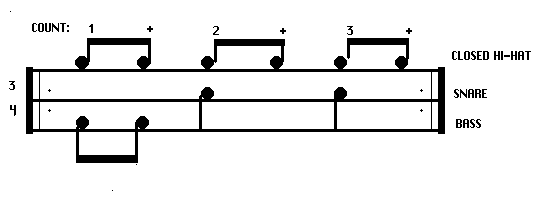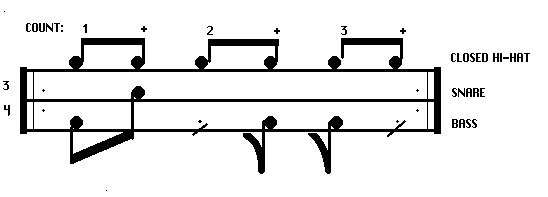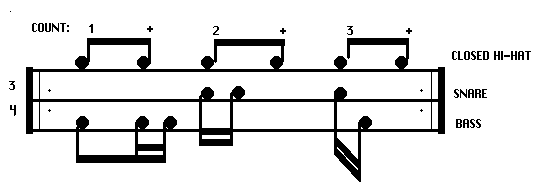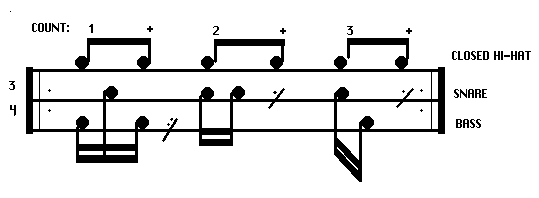The Waltz beat is loaded with many innovative and
fascinating variations. It contains over 5 quintillion, single measure, variation possibilities. In other
words . . . Within every bar of every Waltz tune, there are 5 quintillion optional variations we 'could'
play. We rarely scratch the surface. Most Waltz tunes tend to demand the basics only. Waltz has the
reputation as being the most boring beat on the planet. It's really a shame too . . . since there are
so many interesting permutations of it that have never been used in a song.
There are at least 5 Quintillion permutation or variation
possibilities with the waltz beat. First, it is important to realize that the beat can be categorized
in a number of (note value) basic forms.
lesson, mentioned above.)
Having said all that, our next step will be to get a jam going in at least one of the (note value) forms. Let's work on Eighth-note Waltz. You will eventually want to gain expertise with simple variations then add snare and bass syncs later on, eventually dropping fills at random intervals. If you are not familiar with these two terms, 'variations' or 'Syncopations', you will need to back up and study those two online lessons. Variations and syncs work essentially the same way in ANY time signature.
Get your variations and Syncopations happening with 'Eighth
note Rock' first, then it will be easy to get them going in Eight-note
Waltz.
I am surprised Eighth note Waltz isn't more commonly used than
it is. The rhythmic potential is awesome. This beat structure is almost
the same as 8th-note rock except there is one extra count in every
repetition. That extra count makes a big difference in the over all
feel of the rhythms.
Let's look at some of the possibilities . . .
BASIC EIGHTH-NOTE WALTZ:

 Hear it!.
Hear it!.
The objective is to begin a jam with this rhythm structure.
You may do anything you like with it so long as you don't lose track of the count. It might be best to always play a bass on the count of 'one'. . . or downbeat. The downbeat is the first note in every measure. Repeat the rhythm several times then gradually begin to inject your own variations.
Here are a few examples:
EIGHTH-NOTE WALTZ VARIATION EXAMPLES:
A.

 Hear it!
Hear it!
 VIDEO: Click here to 'Play', see, and hear this variation of the 8th Waltz beat.
VIDEO: Click here to 'Play', see, and hear this variation of the 8th Waltz beat.
B.

 Hear it!
Hear it!
 VIDEO: Click here to 'Play', see, and hear this variation of the 8th Waltz beat.
VIDEO: Click here to 'Play', see, and hear this variation of the 8th Waltz beat.
C.

 Hear it!
Hear it!
 VIDEO: Click here to 'Play', see, and hear this variation of the 8th Waltz beat.
VIDEO: Click here to 'Play', see, and hear this variation of the 8th Waltz beat.
Use your imagination! Create a few of your own patterns, then you can begin to think about adding syncs.
EIGHTH-NOTE WALTZ SYNCOPATION EXAMPLES:
D.

 Hear it!
Hear it!
 VIDEO: Click here to 'Play', see, and hear this variation of the 8th Waltz beat.
VIDEO: Click here to 'Play', see, and hear this variation of the 8th Waltz beat.
E.

 Hear it!
Hear it!
 VIDEO: Click here to 'Play', see, and hear this variation of the 8th Waltz beat.
VIDEO: Click here to 'Play', see, and hear this variation of the 8th Waltz beat.
 Hear all the Waltz beats played back to back.
Hear all the Waltz beats played back to back.
Again, use your imagination and create a few of your own ideas!
*** ADDING FILLS ***
Adding fills to the Waltz beat is easy! Stick with 3 group
patterns in the beginning. Start your fill on the count of 'one' and play
THREE groups of your chosen roll, then return to the hi-hat on 'one' of the next measure. Try 16th singles, doubles, paradiddles, 8th triplets, Rogers ruffs, 8th notes, 16th triplets or any other roll that you might take a fancy to.
 VIDEO: Click here to 'Play', see, and hear the 8th Waltz beat with a 16th single stroke fill.
VIDEO: Click here to 'Play', see, and hear the 8th Waltz beat with a 16th single stroke fill.
If you are having trouble with rolls, see these two lessons:
1. Rudiments, Rolls & Fills (PART I)
and
2. Rudiments, Rolls & Fills (PART II)
We have only focused on one (note-value) form of Waltz in this lesson but common sense should dictate the rest. Strive to jam comfortably in each of the (note value) forms of Waltz.
- 1. 16th Waltz: Jam with variations and add fills. Syncs are only used occasionally within this framework. Fills in this structure will resemble the fills that are used in 16th 4/4. You may want to use 16th triplets and 32nd singles, doubles and paradiddles the most often. Stick with three group rolls at first. Start your fill one 'one' and return to the hi-hat and next beat repetition on 'one' of the next measure.
- 2. Eighth-note triplet Waltz: Jam with variations, syncs and add fills. These fills will resemble the fills you use when playing the 'Blues' beat.
- 3. Shuffle and Swing Waltz: Variations can get complex! They may require a special lesson later. The fills in this framework are much the
same as in Eighth-note Waltz though.
- 4. Quarter-note Waltz: This is a lame pattern though it relates to Quarter Rock. It could get pretty wild if all the sync possibilities are considered.
*** OTHER WALTZ BEAT FORMS ***
- 16th triplet Waltz: Variations abound! This is a VERY interesting rhythm. Can you play it? Can you inject fills?
- 32nd-note Waltz: At the realm of ridiculous! Or . . .is it?
- What is next?

Copyright Bill Powelson 1994 all rights reserved.

